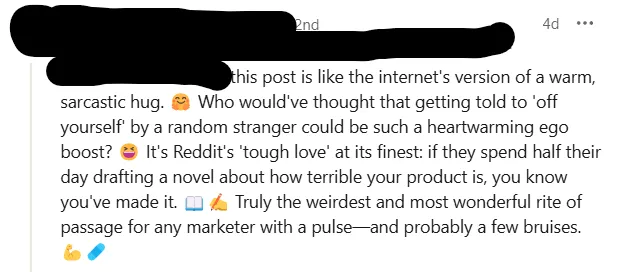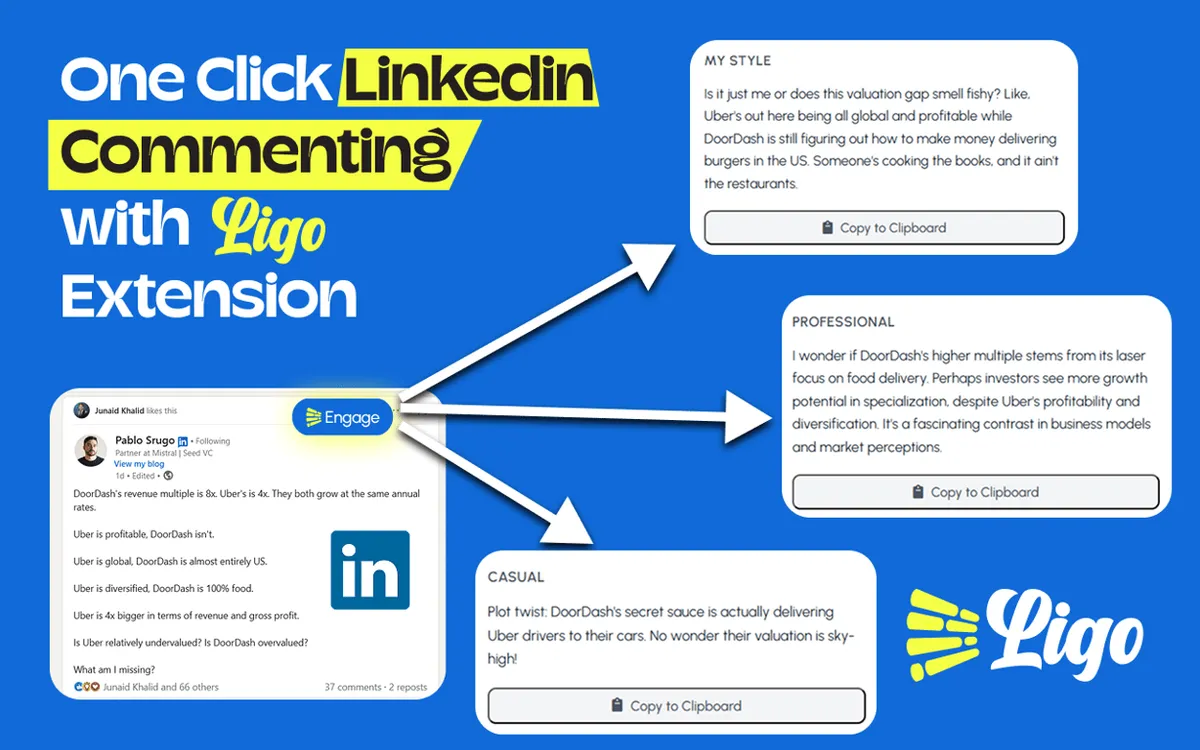LinkedIn has a commenting problem.

Scroll through any popular post and you'll see it - the wasteland of "Great post!" and "Thanks for sharing!" comments that add zero value and make even accomplished professionals look lazy. And if not that, then the kind of travesty you can see above.
For agency owners and freelancers, this creates a massive opportunity.
While others leave forgettable comments, you can use this space to demonstrate expertise, build relationships, and generate leads. I've seen agencies land six-figure deals from relationships that began with a single thoughtful comment.
But what actually makes a LinkedIn comment "good"? After analyzing hundreds of high-performing comments from successful agency owners, I've identified the nine elements that consistently drive results.
The 9 Elements of LinkedIn Comments That Generate Agency Leads
1. Specificity about what resonated
Generic praise is the kiss of death. Instead, pinpoint exactly what you found valuable in the post.
Weak comment: "Great insights! Thanks for sharing."
Strong comment: "Your point about the disconnect between marketing metrics and actual business outcomes really hit home. We're seeing this exact challenge with our SaaS clients right now."
The specific reference shows you actually read and processed the content, immediately differentiating you from 90% of commenters.
2. Personal experience that validates or challenges
Sharing relevant experience transforms you from random commenter to peer with valuable perspective.
Example: "We implemented this exact approach with three enterprise clients last quarter. The results align perfectly with what you're describing - particularly the 30% reduction in onboarding friction. The one difference we noticed was..."
This adds credibility to the original post while positioning you as someone with hands-on expertise.
3. Thoughtful questions that extend the conversation
Questions serve multiple purposes - they show engagement, invite response, and create natural conversation opportunities.
The key is asking questions the post author would genuinely want to answer:
Good questions:
-
"How did this approach differ when working with smaller companies vs. enterprises?"
-
"Did you find any unexpected challenges when implementing this framework?"
-
"I'm curious about the timeframe - how long did it take to see meaningful results?"
Poor questions:
-
"Have you tried [my company's solution]?" (Thinly veiled self-promotion)
-
"What do you think about [completely unrelated topic]?" (Off-topic)
-
"Can you explain this more?" (Too vague)
4. New information that adds value
Contributing additional insights shows you're an informed participant in the conversation.
Example: "Building on your point about GA4 implementation challenges, we're seeing a specific issue with cross-domain tracking that many aren't discussing yet. According to Google's latest documentation, the recommended approach is now..."
This positions you as genuinely knowledgeable while providing actionable value to everyone in the thread.
5. Respectful counterpoints (when appropriate)
Echo chambers rarely produce meaningful discussion. Thoughtful disagreement, when handled correctly, creates memorable interactions.
The formula for effective counterpoints:
-
Acknowledge the merit in the original perspective
-
Present your alternative view with supporting rationale
-
Frame it as an addition rather than a correction
Example: "I appreciate this framework for agency pricing - it's exceptionally clear. We've taken a somewhat different approach by focusing on outcome-based pricing rather than hourly rates. We found that for retention-focused projects, clients respond better to pricing tied directly to measurable improvements in customer lifetime value. I wonder if pricing models need to align with specific types of client objectives?"
6. Concise, scannable structure
Even brilliant insights get ignored when buried in a wall of text. High-performing comments typically:
-
Keep to 3-5 sentences (or use clear formatting for longer comments)
-
Use line breaks to create visual breathing room
-
Highlight key points with occasional formatting (used sparingly)
-
Get to the point quickly
Remember: most people scan LinkedIn on mobile devices. Structure your comments accordingly.
7. Authentic voice that matches your brand
The most effective agency comments have a distinct voice that aligns with their brand positioning.
A cybersecurity agency might use precise, technical language that demonstrates expertise, while a creative agency might take a more conversational, innovative approach.
Whatever your voice, consistency builds recognition over time.
8. Strategic vulnerability when relevant
Counterintuitively, admitting challenges or failures can make your comments more compelling and trustworthy.
Example: "We tried implementing this exact reporting framework last year and honestly struggled with getting client buy-in initially. What finally worked was creating a simplified dashboard view for executives while maintaining the detailed metrics for the marketing team. The dual approach increased adoption by 80%."
This type of strategic vulnerability demonstrates honesty and problem-solving ability - qualities clients value in agency partners.
9. Contextual awareness of the conversation
Understanding the existing comment thread before adding your voice shows social intelligence and prevents redundancy.
Before commenting, scan existing comments to:
-
Avoid repeating points others have made
-
Build on relevant thoughts from other commenters
-
Reference particularly insightful comments
Example: "Building on Sarah's point about measurement challenges, we've found that integrating qualitative feedback loops has been crucial for our B2B clients where the sales cycle exceeds 90 days..."
Beyond the Elements: The Comment Strategy That Drives Agency Growth
Understanding these elements is just the beginning. The real power comes from implementing a systematic approach to LinkedIn commenting.
The "Value First" Framework for Agency Comments
We've developed this straightforward framework to guide effective commenting:
-
Validate - Acknowledge the value in the original content
-
Add - Contribute new information or perspective
-
Link - Connect to broader context or implications
-
Understand - Ask a thoughtful question to deepen understanding
-
Engage - Invite continuation of the dialogue
Using this VALUE framework ensures your comments consistently hit the key elements that drive engagement.
Where Agency Owners Should Focus Their Commenting Efforts
Not all LinkedIn posts deserve your thoughtful comments. Strategic focus is crucial.
Priority 1: Ideal client conversations Identify 10-15 potential clients posting regularly about topics relevant to your services. Engage consistently with their content using the elements above.
Priority 2: Industry thought leaders Comment on posts from recognized experts in your field, particularly when their audience overlaps with your target clients.
Priority 3: Trending discussions in your niche When industry-specific conversations gain traction, adding valuable perspective increases your visibility to potential clients following that topic.
Common LinkedIn Comment Mistakes Agency Owners Make
Even understanding the key elements, many agency professionals undermine their effectiveness with these common errors:
Self-promotion too early
Turning every comment into a pitch destroys credibility. Build relationship equity before even hinting at your services.
Commenting without context
Dropping into conversations without understanding the history or community norms can make you appear tone-deaf.
Generic template comments
While frameworks are helpful, obviously templated comments appear inauthentic. Customize each engagement.
Drive-by commenting
Leaving a comment and never returning to engage with responses wastes relationship-building opportunities.
Comment-baiting
Asking transparent engagement-farming questions ("Who else agrees?" or "Am I the only one who...?") looks desperate and unprofessional.
How Technology Can Enhance Your LinkedIn Commenting Strategy
For busy agency owners, technology can help maintain consistent, high-quality engagement without consuming hours each day.
Tools like LiGo's Chrome extension can analyze post content and generate contextually relevant comment options that match your professional voice – saving precious time while maintaining authenticity.
The extension provides multiple comment options in different styles:
-
Professional and authoritative
-
Conversational and approachable
-
Thought-provoking and analytical
This allows you to maintain a consistent presence even during your busiest periods, ensuring you never miss valuable engagement opportunities.
Case Study: From Comments to Clients
Jason, founder of a 7-person digital strategy agency, implemented a focused commenting strategy using these nine elements.
His approach:
-
Identified 20 potential clients regularly posting on LinkedIn
-
Committed to leaving thoughtful comments on their posts 2-3 times weekly
-
Used the VALUE framework to structure his comments
-
Tracked engagement in a simple spreadsheet
After 60 days:
-
8 profile visits from target prospects
-
5 direct message conversations
-
3 discovery calls
-
1 new client worth $72,000 annually
The entire effort required approximately 20 minutes daily, demonstrating the exceptional ROI of strategic commenting compared to other business development activities.
Start Building Your LinkedIn Comment Strategy Today
Effective LinkedIn commenting isn't complicated, but it does require intention and consistency.
Begin by:
-
Identifying 5-10 key accounts to engage with regularly
-
Creating a simple comment framework based on the elements above
-
Setting aside 15 minutes daily for strategic engagement
-
Tracking results to refine your approach
Remember that commenting is often more valuable than posting your own content. While everyone focuses on creating posts, the real relationships happen in the comments.





